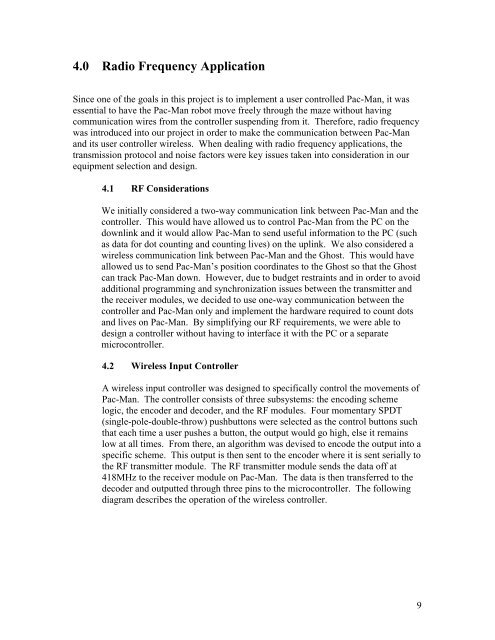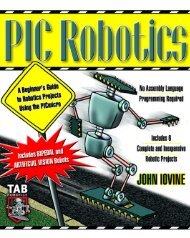You also want an ePaper? Increase the reach of your titles
YUMPU automatically turns print PDFs into web optimized ePapers that Google loves.
4.0 Radio Frequency ApplicationSince one of the goals in this project is to implement a user controlled Pac-Man, it wasessential to have the Pac-Man <strong>robot</strong> move freely through the maze without havingcommunication wires from the controller suspending from it. Therefore, radio frequencywas introduced into our project in order to make the communication between Pac-Manand its user controller wireless. When dealing with radio frequency applications, thetransmission protocol and noise factors were key issues taken into consideration in ourequipment selection and design.4.1 RF ConsiderationsWe initially considered a two-way communication link between Pac-Man and thecontroller. This would have allowed us to control Pac-Man from the PC on thedownlink and it would allow Pac-Man to send useful information to the PC (suchas data for dot counting and counting lives) on the uplink. We also considered awireless communication link between Pac-Man and the Ghost. This would haveallowed us to send Pac-Man’s position coordinates to the Ghost so that the Ghostcan track Pac-Man down. However, due to budget restraints and in order to avoidadditional programming and synchronization issues between the transmitter andthe receiver modules, we decided to use one-way communication between thecontroller and Pac-Man only and implement the hardware required to count dotsand lives on Pac-Man. By simplifying our RF requirements, we were able todesign a controller without having to interface it with the PC or a separatemicrocontroller.4.2 Wireless Input ControllerA wireless input controller was designed to specifically control the movements ofPac-Man. The controller consists of three subsystems: the encoding schemelogic, the encoder and decoder, and the RF modules. Four momentary SPDT(single-pole-double-throw) pushbuttons were selected as the control buttons suchthat each time a user pushes a button, the output would go high, else it remainslow at all times. From there, an algorithm was devised to encode the output into aspecific scheme. This output is then sent to the encoder where it is sent serially tothe RF transmitter module. The RF transmitter module sends the data off at418MHz to the receiver module on Pac-Man. The data is then transferred to thedecoder and outputted through three pins to the microcontroller. The followingdiagram describes the operation of the wireless controller.9




